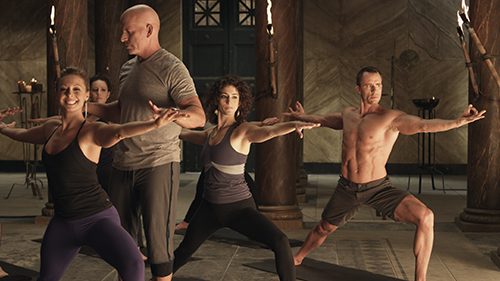Just like the sun, which rises in the east but sets in the west, yoga's home is right here in the US of A. Here are five ways the West has improved yoga.
1. Saving "asana" yoga.
What you perceive as yoga, the physical act of passing through vinyasas, is actually only a marginal subset of the ancient practice of yoga. Traditional yoga is outlined in sutras of the Yoga Sutras, a philosophy book that is a foot tall. It's really an academic practice more than a physical one. Physical yoga, or asana (which means "posture"), was almost extinct in the motherland (India) due to a lack of interest in its younger population. Vivekananda may have brought yoga to the West at a Boston religious conference in 1893, but it wasn't until the 1950s when Walt and Magana Baptiste introduced what we consider to be physical "Yoga" to the West that asana was saved.
For those who practice physical yoga, the physical is merely a portal to all the profound philosophies that yoga is rooted in. So thanks to the West, when you're on your mat, you get a workout and some spiritual enlightenment at the same time. Two for one? What's more American than that?
2. Promoting the here and now.
Mother India and its inhabitants are all about the after life. That's not necessarily a bad thing, but in the West we've learned that there's nothing better than living your life to the fullest, right here and now. Take one look at India's current state, with rampant poverty and violence (especially towards women) and you'll agree that a little more attention to the current life is warranted. In contrast to India, the West takes a very "here and now" approach to yoga. At the end of each class, you'll feel invigorated and empowered, physically, mentally and spiritually. Why wait until the afterlife to feel that?
3. Embracing women's rights.
Can you imagine that until 50 years ago, women in India weren't even allowed to practice yoga? It was a purely patriarchal activity. In the West, 20 million people (and growing daily) practice yoga, and of those, over 80 percent are women. Western yoga has empowered women, while women in India continue to experience limited rights, both when it comes to yoga and beyond.
4. Putting India on the map.
Yoga may have originated from India, but it wasn't until yoga took off in the West that India was thrust into the public limelight. Think about how many of your fellow yogis are making pilgrimages to "Mother India." Think about Eat, Pray, Love. Think about how ubiquitous Indian teachings, foods and fashions have become. Yoga in the West played a huge part in putting India on the map.
5. Achieving world peace.
Once yoga made its way to the West, celebrities like Madonna and Sting were some of the first to jump on board. When Madonna practices yoga, yoga gains a global audience. That's some powerful stuff because not only is yoga taking center stage, but yoga's deeper principles of peace, tolerance and acceptance get shared as well. World peace through yoga? I wouldn't count it out.
